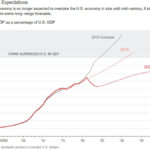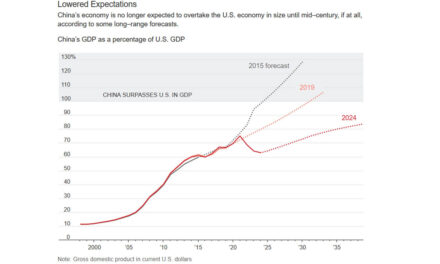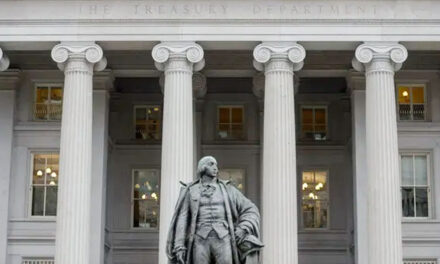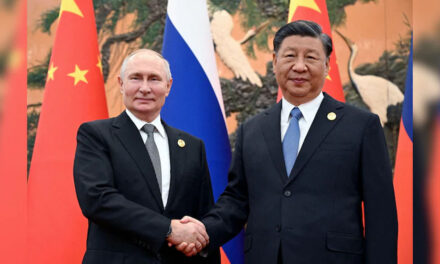
The Trade Deficit Exploded, Here’s Why That’s Totally Fine
A substantial facet of President Trump’s foreign policy platform appears to be going relatively poorly recently.
Despite Trump’s application of a myriad of tariffs and import restrictions on foreign goods and services flowing into American households, the US trade deficit for 2018 hit a decade high mark thanks in part to an equally historically high December deficit. The BBC explains,
“The US trade gap with the rest of the world jumped to a 10-year high of $621bn (£472.5bn) last year, dealing a blow to President Donald Trump’s deficit reduction plan.
The trade deficit is the difference between how much goods and services the US imports from other countries and how much it exports. Reducing the gap is a key plank of Mr. Trump’s policies. But in 2018, the US exported fewer goods compared with how much it bought.
Mr. Trump claims that the US is being “ripped off” by other nations and wants countries to lower their tariffs on US goods and buy more of them. However, official data shows that while exports of US goods and services rose by $148.9bn last year, imports jumped by $217.7bn.
It means that the gap is the widest since 2008, when the global financial crisis hit and the US fell into recession. The deficit in goods and services during December also hit a near 10-year high of $59.8bn. Exports to the rest of the world fell 1.9% to $205.1bn, while imports rose by 2.1% to $264.9bn.”
Perhaps even more hypothetically worrying the trade gap in goods – referring to what economists call ‘visible’ imports and exports like raw materials as opposed to say, financial advising – hit an all-time high as America gorged on products from the likes of Mexico, China, and Germany.
But before you panic, realize this development actually makes a lot of sense given the domestic context. The Trump tax cuts catalyzed a massive spike in consumer spending in 2018, leading Americans to naturally spend even more on imports than before. Additionally, the tariffs imposed by the White House almost certainly contributed to higher *short-term* deficits by spurring American companies to speed up purchases of foreign goods before tariffs took effect.
But here’s the twist, it’s completely and totally fine that this happened. In fact, it can – perhaps counterintuitively – be indicative of very good things. But to understand why this is true we’ll need to delve into the nature of trade deficits.
Trade Deficits Aren’t Evil: They Can Even be Beneficial
There’s no denying that trade deficits as a concept can be confusing, especially when attempting to navigate the trillions of dollars flowing back and forth in the globalized economy.
But if we can shed the insurmountable numbers and get to the core concept; as well as overcome the instant fear of the term ‘deficit’, perhaps exactly *why* trade deficits can be good will become clear. One Forbes writer does exactly this expertly,
“A trade deficit occurs when Nation X purchases more goods and services (by value) from Nation Y than Y purchases from X. In this example, X has a trade deficit with Y and Y has an identical trade surplus with X.
And that works for every other country that we run a trade deficit or surplus with. We buy their goods, they take our dollars. And that’s not bad. In fact, it’s arguably better for the U.S. side because China (and everyone else) accepts our currency as payment [for goods and services with actual tangible value].
Actually, trade deficits are the reason the U.S. dollar is the world’s reserve currency. We ship enormous quantities of greenbacks overseas to pay for all the stuff we import. Chinese investors use them to buy our Treasury bonds or other purchases. The money flows to other countries and companies and eventually comes back to the U.S.
Their added demand lets our Treasury borrow at lower rates than it otherwise could. In effect, the trade deficit [also] subsidizes our government debt.”
The lesson here is trade deficits are not always bad for U.S. workers and consumers. In fact, a powerful economy like the US – in fact especially the US being by far the largest economy – is almost guaranteed a trade deficit thanks directly to the purchasing power of its people; you and me.
American Prosperity means America Imports
Consider this; China’s average income, converted to dollars, sits at a paltry $8,690. Meanwhile in the US that number skyrockets to $58,270. Thus, which country’s consumers are going to buy more ‘stuff’ is glaringly apparent. So too should be the origins of the trade deficit.
At its most basic a trade deficit simply means US consumers spent their green, literally inherently worthless paper, on goods with tangible value from other countries. What’s more the massive gap between the money people in the US can swing around compared to say, Mexicans, mean we’re very much coming out of those transactions ‘on top’.
Think about it, if you make very few dollars that naturally means dollars are worth more to you relative to your goods. That’s why when Americans show up in the Yucatan on a cruise ships with massively more wealth than the natives – and thus a lower relative value to goods – they regularly take advantage of the deep discounted ‘deals’. Of course, the Mexicans – who again regard those dollars with higher relative value – are happy to deal even though from an American economic perspective they’re being ‘taken advantage of’.
And that right there is really the crux of the trade deficit; we’re fabulously wealthy compared to most of the world and as a result we can use less dollars than we otherwise might have to, to get more value in goods from everyone else. It couldn’t be further from a problem.
A Desirable Deficit?
Still not convinced or maybe somewhat confused? Harvard Business Review perhaps makes things clear,
“Do a little thought experiment: Imagine that your country is the world’s most attractive country in which to invest capital, because it has the biggest and richest market in the world, and the world’s most used and tradable currency, and it is scrupulous about protecting the rights of investors. Imagine further that its advanced economy is leading the world in the transition to a service-based economy, and as a result, it runs the world’s biggest services trade surplus — by a factor of more than two over the next biggest surplus in the world.
Per standard macroeconomic theory, this imaginary country would run the world’s biggest deficit in traded goods. And it would have absolutely nothing to do with its being uncompetitive or its people profligate. It can’t be the best place to invest and the best service exporter without running a huge goods trade deficit. (Because, remember, all three things have to sum to zero.) Well, the mystery country is, of course, the U.S. — and the U.S. trade deficit, according to this argument, is a logical consequence of America’s success and superior know-how relative to other countries. On this basis, the trade deficit should be something to brag about rather than denounce.”
So, while the trade deficit’s recent bloating might be considered a negative development to many, likely including Donald Trump himself, the reality is that spike more than anything indicates he’s at the helm of an extremely strong US economy. A US economy that wants to buy things for the best value possible. In short, in an ironic twist it’s ‘Trump’s economy’ that’s spiking his trade deficit.
Trade deficits can be disconcerting, and the negative stigma of the concept of ‘deficit’ often leads to politicians and regular folks alike loudly decrying them even if they haven’t been caused by negative developments; like a massive dip in exports as per the 2008 recession.
But the real hard economic truth at the end of the day is it simply means America is doing rather well.


























Joe Gilbertson: where are you going with these threats? My free speech is facing intimidation, sometimes physical threats. Is this…
NOT BUSTED. You didn't have to say it. That is what I meant in the above post from me. But…
Just another ruse for taking jabs at Biden through alleged short comings of his. Ten days remaining in Biden's term…
I never said I WANT China to continue to own Panama. You made that up. First,I didn’t say it. Second.…
I absolutely do Not in any way, shape or manner fabricate ANYTHING you say. I do and will always tell…